
All iLive content is medically reviewed or fact checked to ensure as much factual accuracy as possible.
We have strict sourcing guidelines and only link to reputable media sites, academic research institutions and, whenever possible, medically peer reviewed studies. Note that the numbers in parentheses ([1], [2], etc.) are clickable links to these studies.
If you feel that any of our content is inaccurate, out-of-date, or otherwise questionable, please select it and press Ctrl + Enter.
Tuberculosis pills
Medical expert of the article
Last reviewed: 03.07.2025
Tuberculosis is a serious infectious disease that develops after infection with a special type of bacteria - mycobacteria. Today, the most effective medicines are tuberculosis pills.
Pharmacological group
Pharmachologic effect
Indications tuberculosis pills
Tuberculosis tablets are used in the event of the following main symptoms of this disease:
- Constantly elevated body temperature, most often subfebrile.
- A very strong cough, sometimes the patient may cough up blood.
- The patient loses weight rapidly and significantly.
- Frequent headaches.
- Shortness of breath when walking and severe night sweats.
Release form
Tuberculosis usually affects men over 40. There are several types of this disease. The most common is pulmonary tuberculosis, but tuberculosis of the joints and bones, and tuberculosis of the genitourinary system are also found. Despite all its seriousness, this disease can be cured with the help of modern medical drugs, in particular various tablets that are sold in pharmacies. How are they different?
Different types of tablets have been proposed by the International Union Against Tuberculosis. They can be divided into three distinct categories:
- Tablets with flomiricin sulfate.
- Tablets based on streptomycin sulfate.
- Preparations containing cycloserine.
Another classification is also used. It divides all tuberculosis pills into two large groups:
- First row: Streptomycin, Isoniazid and others.
- Second row: Ethionamide, Cycloserine, Kanamycin.
As you can see, various antibiotics and synthetic agents are mainly used against tuberculosis.
Let's take a closer look at popular tuberculosis pills.
Isoniazid
A bactericidal drug used to treat tuberculosis patients. It exhibits strong activity against intracellular and extracellular Mycobacterium tuberculosis bacteria. It is also used as a preventive measure against the disease in people and family members who are in constant contact with infected patients.

The dosage is determined by the attending phthisiologist. It depends on the severity of the disease and its form. Usually, Isoniazid tablets are taken once a day (300 mg). Treatment can last for several months, depending on the severity of the form. In no case should the maximum daily dose be exceeded - 300 mg.
Isoniazid is prohibited for patients who suffer from epilepsy, poliomyelitis, atherosclerosis, and also suffer from seizures. Patients taking this drug should be prepared for side effects: headaches, gynecomastia, allergies, nausea and even vomiting.
Rifampicin
A popular antibiotic that is often used to treat patients with tuberculosis. It has a good bactericidal effect, inhibits the synthesis of Mycobacterium tuberculosis RNA. It may exhibit additional activity against Clostridium spp., Streptococcus spp., Staphylococcus spp., Bacillus anthracis, Legionella pneumophila, Rickettsia prowazekii, Neisseria meningitidis, Chlamydia trachomatis.
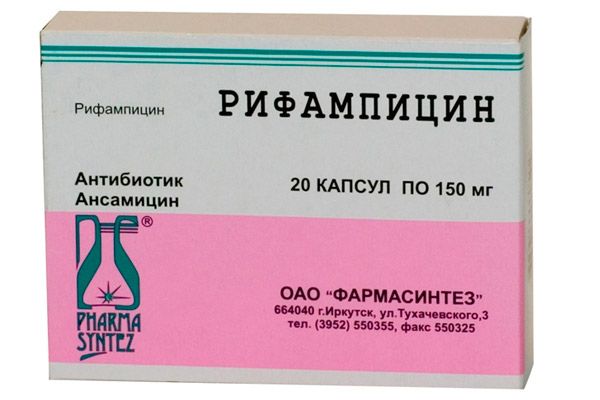
Take the tablets only on an empty stomach, with plenty of water. The dosage is standard for children and adults - once a day, 10 mg per kilogram of weight.
Patients who suffer from jaundice, pyelonephritis, hepatitis, kidney disease, taking Rifampicin is contraindicated. Also, you cannot take the tablets if the patient may develop an allergy to rifampicin. Pregnant women can be prescribed the drug only when the disease can have negative consequences for their health and life. In some cases, unpleasant symptoms may occur after taking the tablets: Quincke's edema, diarrhea, vomiting, hepatitis, eosinophilia, headaches, menstrual irregularities.
Rifabutin
A popular antibiotic that belongs to the rifamycin group. It is used to treat pulmonary tuberculosis, as it exhibits activity against M.avium intracellulare complex and M.tuberculosis. The active substance that is part of the drug is rifabutin.

Rifabutin tablets can be taken regardless of food intake once a day. The drug can be used as a preventive measure. In this case, the patient should take a tablet once at a dosage of 300 mg. If tuberculosis has not been diagnosed for the first time, therapy using Rifabutin continues for at least six months.
If the patient is also diagnosed with liver or kidney failure or intolerance to rifabutin, these tablets should not be taken. Pregnant women and nursing mothers are prohibited from taking the drug. Sometimes patients note that taking Rifabutin leads to vomiting, nausea, diarrhea, headaches, bronchospasms, anemia, arthralgia.
Streptomycin
A popular antibiotic that belongs to the group of drugs with aminoglycosides. It is active against the following bacteria: Mycobacterium tuberculosis, Neisseria gonorrhoeae, Salmonella spp., Escherichia coli, Yersinia spp., Shigella spp., Klebsiella spp., Haemophilus influenzae, Francisella tularensis, Corynebacterium diphtheriae, Staphylococcus spp., Enterobacter spp., Streptococcus spp..
The attending physician individually determines the appropriate dosage and duration of therapy for each patient. However, it is not allowed to take more than the established maximum daily dose: 4 g of the drug.
Patients with myasthenia, obliterating endarteritis, cardiovascular or renal failure, and brain dysfunction are prohibited from taking the drug. Pregnant women and patients during lactation are also prohibited from using the drug.
Streptomycin can lead to the development of some unpleasant symptoms: diarrhea, albuminoria, hearing loss, nausea and vomiting, headache, allergies.
Kanamycin
A popular antibiotic that is included in the list of aminoglycosides. It is characterized by fairly high activity against many bacteria: Staphylococcus spp., Klebsiella pneumoniae, Escherichia coli, Salmonella spp., Shigella spp., Enterobacter spp., Proteus spp., Neisseria meningitidis, Neisseria gonorrhoeae.
For the treatment of adult patients who are sick with tuberculosis, Kanamycin is used according to the following scheme: six days, 1 g once every 24 hours. For the treatment of children: 15 mg once every 24 hours. On the seventh day, take a break. The doctor determines the duration of treatment depending on the severity of the disease.
Patients with hearing problems, liver problems, and gastrointestinal diseases cannot take Kanamycin. Also, the drug cannot be used by pregnant women. The drug is prohibited for use simultaneously with those antibiotics that have nephrotoxic and ototoxic effects. Sometimes taking the antibiotic Kanamycin can be accompanied by such unpleasant symptoms: headaches, increased fatigue and drowsiness, granulocytopenia, anemia, constant ringing in the ears, hearing impairment, frequent urination, cylindruria, allergies.
Metazid
Metazide is a derivative of isonicotinic acid hydrazide. It damages the membrane of Mycobacterium tuberculosis bacteria, causing their death.
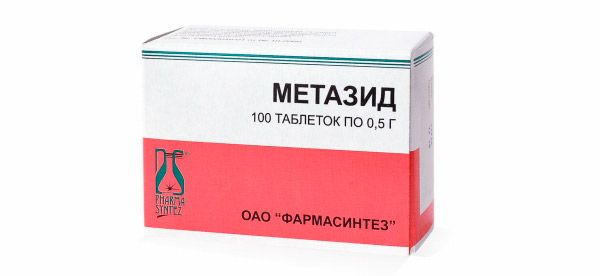
Metazid can be taken by adults no more than 2 g per day, and by children – 1 g. It is necessary to divide this dose into several doses (two or three). The drug is used to treat any form of tuberculosis.
Patients with angina, central nervous system diseases, heart defects and renal failure are completely prohibited from taking Metazid tablets. The same applies to pregnant women. During therapy, it is necessary to examine the fundus from time to time.
When using the anti-tuberculosis drug Metazid, some patients may experience side effects: peripheral neuritis, dizziness, which is accompanied by severe headaches, convulsions, insomnia, euphoria, memory loss, vomiting, nausea, diarrhea, pain in the heart area (only with long-term use).
Viomycin
Anti-tuberculosis tablets based on the active substance (antibiotic) viomitsin. It has a bacteriostatic specific effect on many bacteria: Streptomyces floridae, Mycobacterium tuberculosis. It is a second-line anti-tuberculosis drug.
The attending physician prescribes the dosage and duration of therapy individually for each patient. They depend on the severity of the disease and its form.
Patients with impaired renal function, as well as intolerance to the antibiotic, cannot take this drug. Use with extreme caution when treating children, as the tablets may affect hearing development. Do not prescribe simultaneously with other tuberculosis tablets (monomycin, neomycin or kanamycin). Very often, hearing impairment, headaches, proteinuria and allergies are possible during the use of Viomycin.
Cycloserine
An anti-tuberculosis drug that contains the antibiotic cycloserine. It has a broad spectrum of action. It can act bactericidally or bacteriostatically against the following bacteria: Mycobacterium tuberculosis, Rickettsia spp..

You should take Cycloserine tablets for tuberculosis before meals. It is better to take the medicine after meals. For the first 12 hours, take 0.25 g. Then the dose can be increased by 250 mg every eight hours. Do not take more than the maximum daily dose (1 g).
Patients with hypersensitivity, epilepsy, central nervous system diseases, mental disorders, renal and cardiac insufficiency, alcoholism are prohibited from taking the drug. When treating children, take with caution.
Cycloserine tablets may cause the following side effects: heartburn, vomiting, diarrhea, sleep disturbances, headaches, psychosis, emotional depression, memory impairment, tremors, severe cough, fever.
Ethambutol
Tablets for tuberculosis, which include ethambutol hydrochloride. They are distinguished by their bacteriostatic action against atypical and typical mycobacteria.
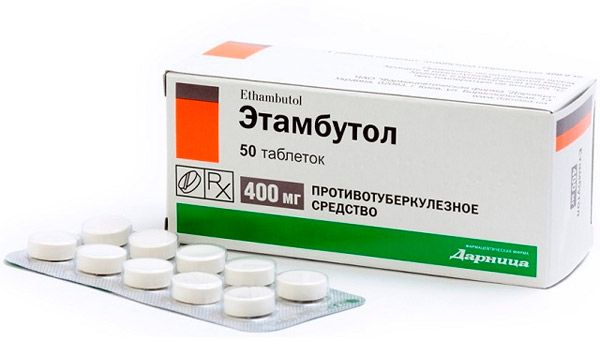
The treatment is carried out in stages. At first, 15 mg per kilogram of the patient's body weight is prescribed once a day. The dose is gradually increased to 30 mg per kilogram of body weight. The course of therapy is nine months. If the patient is diagnosed with renal failure, the dosage is prescribed based on the creatinine clearance rate.
Patients with cataracts, various inflammatory processes in the eyes, gout, diabetic retinopathy, renal failure cannot take Ethambutol, as the drug can cause severe side effects. The drug is also prohibited for pregnant women and small children.
Very often, when taking these pills, retrobulbar inflammation of the optic nerve may occur, which leads to deterioration of visual acuity. Patients also note headaches, nausea, an unpleasant taste in the mouth, hallucinations, sleep disorders, and convulsions.
 [ 12 ], [ 13 ], [ 14 ], [ 15 ]
[ 12 ], [ 13 ], [ 14 ], [ 15 ]
Prothionamide
Protionamide, which is used to treat tuberculosis, is a second-line drug. Its mechanism of action is to block the synthesis of mycolic acid, which is considered the main structural element in the bacterial membrane wall. It can be used with other anti-tuberculosis drugs to reduce the possibility of developing resistance.
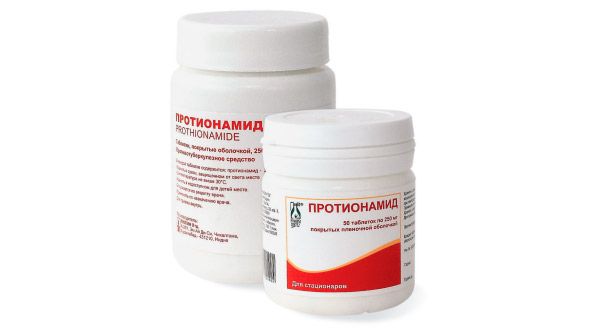
The tablets must be taken strictly after meals. Adults take 0.25 g three times a day, if the patient tolerates the drug well, the dose can be increased to 0.50 g.
Patients who have also been diagnosed with liver cirrhosis, acute gastritis, acute hepatitis, colitis, cannot take Protionamide. The drug is also prohibited for use by people who abuse alcohol and pregnant women.
During therapy with Protionamide, patients may experience the following side effects: vomiting, loss of appetite, hypersalivation, pellagra-like reaction, hypoglycemia, gynecomastia, hypothyroidism, headache, mental disorders.
Pyrazinamide
An anti-tuberculosis drug of synthetic origin, which belongs to the second line of medicines for tuberculosis. It is used to treat tuberculosis of any form simultaneously with other drugs of this group. It has a bactericidal or bacteriostatic effect on bacteria, depending on their sensitivity.
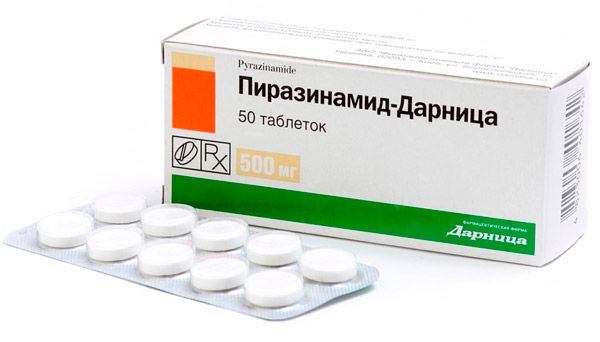
The dosage is prescribed by the attending physician individually. The maximum daily dose of Pyrazinamide tablets is 2 g of the drug if taken once a day, and 3 g of the drug if taken twice a week.
Patients with pyrazinamide intolerance or severe liver failure are prohibited from taking the tablets. In some cases, taking Pyrazinamide can lead to nausea, vomiting, liver dysfunction, arthralgia, allergies, gout.
Phthivazid
Anti-tuberculosis tablets based on isonicotinic acid hydrazide derivative. They are distinguished by selective activity against Mycobacterium tuberculosis bacteria.
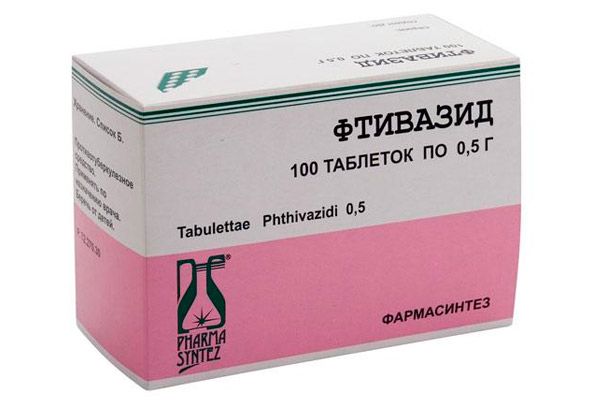
The tablets should be taken two or three times a day at a dosage of 500 mg at a time (adults) or 30 mg per kilogram of weight (children). Do not exceed the maximum daily dose of 3 g.
Patients with angina, central nervous system diseases, heart defects, kidney diseases are contraindicated to take Ftivazid tablets. In some cases, patients develop the following symptoms while taking Ftivazid: gynecomastia, menorrhagia, heart pain, allergies, vomiting, psychosis, memory impairment, headaches.
Thioacetazone
A synthetic antibacterial agent against tuberculosis. Thioacetazone tablets can be taken only after meals. The dosage is usually prescribed by the attending physician, but is most often as follows: 0.1 or 0.15 g per day. The dose can be divided into several doses. Be sure to wash down the drug with a sufficient amount of water.
The drug should not be used to treat tuberculous meningitis. During therapy, the patient must be closely monitored. It is necessary to monitor the kidneys and liver. It is necessary to stop taking the drug if the patient has agranulocytosis.
Patients with impaired renal and hepatic function, intolerance to thioacetazone or diseases of the hematopoietic organs are prohibited from taking these tablets. In some cases, the following side effects were found: diarrhea, vomiting, abdominal pain, hepatitis, agranulocytosis, anemia, leukopenia, dermatitis, cylindruria, headaches.
PAS tablets
An anti-tuberculosis drug with the active ingredient aminosalicylic acid.
PAS tablets should be taken half an hour to an hour after meals. Wash down with a sufficient amount of water. Adults are prescribed 12 g per day, divided into three to four doses. If the patient is too exhausted, the dose is reduced to 6 g. For the treatment of children, 0.2 g per kilogram of weight is used three to four times a day. But the dosage should not exceed 10 g per day.
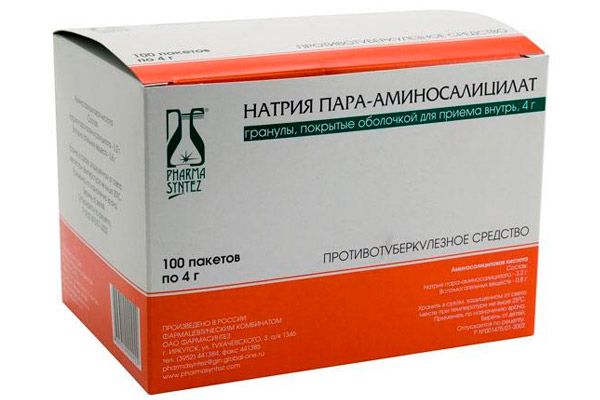
Patients with hypersensitivity to salicylates, liver and kidney diseases, gastrointestinal ulcers, myxedema, epilepsy are prohibited from taking the drug. In some patients, taking PAS tablets caused side effects: constipation or diarrhea, vomiting, abdominal cramps, jaundice, hepatitis (sometimes fatal), urticaria, hypoglycemia, vasculitis, hypothyroidism, proteinuria, dermatitis, anemia.
Capreomycin
An antibiotic for the treatment of tuberculosis, a derivative of aminosalicylic acid. It is effective only against Mycobacterium tuberculosis bacteria.
As a rule, Capreomycin is prescribed in combination with other anti-tuberculosis drugs. The dosage is always individual, as it depends on the form of tuberculosis and the severity of the disease. Therapy can last from six months to a year.
It is not recommended to use Capreomycin to treat patients under 18 years of age, as its effectiveness in this case has not been established. Patients with liver and kidney failure should use the tablets with extreme caution. It is prohibited for pregnant women.
Overdose of Capreomycin is possible, which causes a nephrotoxic effect. Frequently, the drug causes neurotoxicity, leukopenia, cylindruria, hypokalemia, leukocytosis, thrombocytopenia, hypomagnesemia, partial deafness, aseptic abscesses, bleeding, and allergy.
Pharmacodynamics
Let us consider the pharmacodynamics and pharmacokinetics of tuberculosis tablets using the popular drug Isoniazid as an example.
This drug is included in the so-called first-line tablets. It has a bactericidal effect on microorganisms that cause tuberculosis Mycobacterium tuberculosis. It has an inhibitory effect on DNA-dependent RNA polymerase and also leads to the suppression of the synthesis of mycolic acid, which is the main structural component of the membrane of bacteria that cause tuberculosis.
Pharmacokinetics
Absorption from the gastrointestinal tract occurs very quickly after taking the Isoniazid tablet. If you take the drug after meals, its bioavailability will be reduced. It quickly begins to distribute throughout all fluids and tissues. It practically does not bind to plasma proteins. It is excreted in feces and urine (75-95%).
 [ 23 ], [ 24 ], [ 25 ], [ 26 ], [ 27 ], [ 28 ], [ 29 ], [ 30 ]
[ 23 ], [ 24 ], [ 25 ], [ 26 ], [ 27 ], [ 28 ], [ 29 ], [ 30 ]
Use tuberculosis pills during pregnancy
Some anti-TB pills, such as Isoniazid, can be prescribed to pregnant women and breastfeeding mothers. But this should be done with extreme caution. Most of these drugs are prohibited during pregnancy, as they can harm the health of the woman and the fetus.
Side effects tuberculosis pills
- Nausea accompanied by vomiting.
- Constipation or diarrhea.
- Headaches that are accompanied by dizziness.
- Agranulocytosis.
- Gynecomastia.
- Mental disorders.
- Euphoria.
- Insomnia.
- Allergic rashes.
If the patient experiences at least one side effect, it is necessary to consult a doctor. He can reduce the dosage of the existing one or prescribe another drug.
Preventive pills for tuberculosis
Tablets are often prescribed for the prevention of tuberculosis. Some of them are also used to treat this disease: Pyrazinamide, Isoniazid, and others. Doctors often prescribe a course of vitamins and minerals, in particular, vitamin B6. Only a phthisiopediatrician can prescribe any drugs to prevent tuberculosis in children.
Chemoprophylaxis with one of the anti-tuberculosis drugs is carried out only in outpatient settings and only for those children who fall into the following risk groups: 4, 5-A, 5-B. Preventive therapy is usually carried out using two drugs simultaneously. As a rule, prophylaxis with tuberculosis tablets is carried out for three months.
Attention!
To simplify the perception of information, this instruction for use of the drug "Tuberculosis pills" translated and presented in a special form on the basis of the official instructions for medical use of the drug. Before use read the annotation that came directly to medicines.
Description provided for informational purposes and is not a guide to self-healing. The need for this drug, the purpose of the treatment regimen, methods and dose of the drug is determined solely by the attending physician. Self-medication is dangerous for your health.

